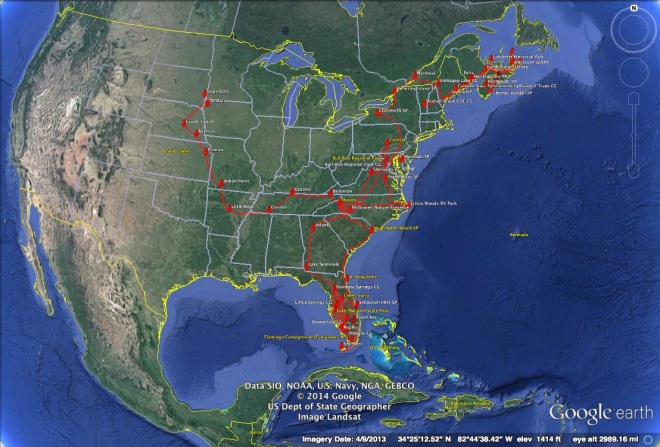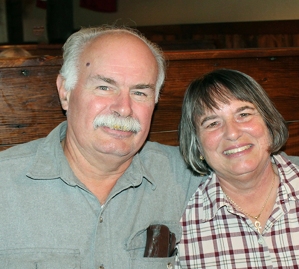Happy New Year to all! We hope you all had as fantastic a year as we did, and hope that 2014 will be even better!
Last year, at New Year’s Day, we posted a blog entry listing our goals for 2013. Well, here we are at New Year’s Day again! How did we do? Here’s a repeat of last year’s post, with our comments and goals for 2014.
In 2013 we said “We can’t imagine a year more exciting, challenging, draining and life altering than 2012. What could 2013 offer? We don’t know and that’s what keeps us on the move as we seek new places, new adventures and check off a bucket list item or two.
I’m not going to call them New Years Resolutions that way I can’t break them. I’ll call them goals instead.”
Here were Chari’s Top 5 For 2013:
1) I want to develop our blog to be more user friendly, add new features and reach 5000 views. In 2012 after just 6 months the blog has 21 followers and reached 1,188 views. Now that’s nothing compared to some of the top rated blogs but we appreciate each and everyone who has taken an interest in Homeless and Loving It!
By New Year’s 2014 – To my utter amazement this was achieved and surpassed. We now have 69 followers on the blog and many more via Facebook, Twitter and Linked-in. We ended 2013 with 11,175 views. So where to go from here? Shall I really reach for the stars by saying I want 25,000 views? Yes.
2) I want to ride a Segway on a tour in some city or other place. I’ve wanted to do this for a long time and now it’s finally reached the top 5.
By New Year’s 2014 – Done and enjoyed in Savannah. Don’t have a new challenge selected for 2014 but I’m sure one will come along.
3) I want to take a sailboat day trip. I’ve been on big ships and small boats. I’ve kayaked and canoed but I’ve never been on a sailboat.
By New Year’s 2014 – Didn’t get out all day but had a wonderful time on an evening cruise in Halifax Harbor.
4) I want to continue seeing National Park sites toward our goal of seeing them all. I haven’t counted recently but I think we are at 60 out of 391. What are the chances of reaching 25% next year? That means 38 more places. Mmmm, a tough one. It’s not the count that matters but the fun and learning along the way.
By New Year’s 2014 – Made it to 22% and our count is 86 NPS sites. So let’s shoot for 30% in 2014. That means 123 sites but we’re heading west and there are more parks out there.
5) See a moose in the wild when I have my camera with me. Two years ago I was kayaking in Idaho when I rounded a bend and came within 100 feet of a cow moose and her calf. I stopped and said “I won’t hurt you” meaning “and I hope you won’t hurt me.” She just looked, decided I didn’t need further investigation and walked away with the calf in tow. To this day I consider this the best wildlife shot I could have had, the one that got away.
By New Year’s 2014 – Saw 5 moose, once w/o the camera handy and 4 when it was too dark to shoot from our truck.
New For 2014 – Two out of five from 2013 are moving forward to 2014. What else should I shoot for?
1) Make myself use my tripod more often. I have a bad habit of just grabbing the camera and taking off.
2) Keep current with our blog. Easier said than done!
3) Get myself out of bed and do sunrise shots. For this I’ll pretend to be going back to work (yup I just said the W word). Definitely easier said than done!
Better not get too carried away I’ve already had enough self-improvement for today.
Here were Steve’s Top 5 For 2013
1- I want an adventure. Something I’ve never done before. 2012 saw two, flying in a hot air balloon, and flying in a sailplane. Don’t know what this new adventure will be, just know that I want one!
By New Year’s 2014 – Well, I don’t know if anything in 2013 qualifies as a special adventure comparing to ballooning or soaring in a sailplane. Guess I’ll have to keep working on this one.
2- Just recently we’ve eaten a couple of meals that place first and second on my all-time favorites. One was Emeril’s recipe for Shrimp and Grits, which we made with fresh caught Gulf Shrimp. The other was our own recipe for Cajun style baked oysters. Don’t know which one places first and which one second, it may be a tie, but at some point in 2013 I want to make and eat a meal that pushes them to second and third place!
By New Year’s 2014 – Finding the Atlantic Snow Crab processing plant in Nova Scotia definitely qualifies! Buying crab right from the factory, bringing it home, making a salad, popping open a beer, and sitting outdoors dipping crab meat into a half dozen different cocktail sauces… Ahh, Life Is Good! And, this meal did double duty! Putting all the shells in a pot and cooking them down made a great stock for a fish chowder! (Or chowdah, as a certain sister-in-law might say)
3- I want a “National Geographic Moment”. I’ve experienced a few in my life, and Chari has had some. One of mine was being so close to Northern Right Whales in the Bay of Fundy that when they spouted, I got wet. Another was being on the fifty-yard line watching while two bull elk locked horns in Rocky Mountain National Park in Colorado. Chari and I watched enthralled as the bats flew in their hundreds of thousands from Carlsbad Caverns in New Mexico and wound their way to the horizon in the twilight sky. I’d like another “National Geographic Moment”.
By New Year’s 2014 – Let’s see… would being up-close and personal with humpback whales in the Bay of Fundy qualify? Umm… YES!
4- I want to experience a moment of pure wonder and serenity. Once, I sat under a pine tree at the Grand Canyon, in the midst of winter, when the only other person in sight was my brother, who also sat under a pine tree about a quarter of a mile away, and watched while the canyon slowly changed colors as the evening sun sank into the western sky. Another was sitting on the beach near the Cape Hatteras Lighthouse watching as the morning sun rose to my left, a thunderstorm raged to my right about a mile or so offshore, and a pod of porpoises played in front of me. And watching a fantastic display of the Northern Lights while driving alone through the night across North Dakota was another. I’d like to experience this feeling again.
By New Year’s 2014 – Driving along a coastal road in Nova Scotia, we turned off on a side road leading to a town called White Point. It turned out to be a small fishing village, maybe a dozen homes and eight or ten fishing boats in the harbor. At the far side of “town” was a path leading out onto a peninsula, about half open meadow, and half wooded. The ocean waves swept the shores on both sides while seabirds soared overhead. We walked passed a grave, marked “The Unknown Sailor”, and I told Chari that we found the place where she could scatter my ashes (hopefully not for another fifty years or so!)
Also in Nova Scotia, near the town of Lunenburg, we kayaked in an area known as Blue Rocks. Paddling through the calm waters, among rocks and islands covered with a golden colored seaweed was absolutely beautiful… rivaling the Antelope Canyon paddle on Lake Powell as the prettiest paddle I’ve ever done.
5- I’d like my life of wandering with Chari to go on forever.
By New Year’s 2014 – Still working on this one, and now we’ve got another year under our belts!
Overall, I’d say that four out of five is pretty darn good, and as for having a great adventure? Well, Life is an adventure, and we’re having one every day, so I guess that makes five out of five!
What are my goals for 2014? I can’t think of any from last year that I would change. Let’s just list the same goals again!
Here’s Opal’s Top 5 For 2013
1- I want to actually catch a squirrel.
By New Year’s 2014 – Still working on this one. But, I’ve come close a couple of times. For 2014, I’m going to add “catching a pelican”. Either one will do!
2- I want to run and roll in the sand on 10,000 more beaches.
By New Year’s 2014 – Only 8372 to go!
3- I want Mom and Dad to take me everywhere and not leave me in the stinkin’ trailer.
By New Year’s 2014 – We’re not making any headway on this one. What does it take to educate those people? Guess I’ll still need to keep rolling my big brown eyes at them when they look like they’re going to leave me alone.
4- I want “people food” with every meal.
By New Year’s 2014 – We’re doing good, but we’re not up to 100% yet. We’ll keep this one on the list too.
5- Just once, I want to be left alone after I’ve fallen asleep for the evening instead of getting woke up to go out and pee.
By New Year’s 2014 – They actually did it! Once. Let’s shoot for two times in 2014.
































































































































